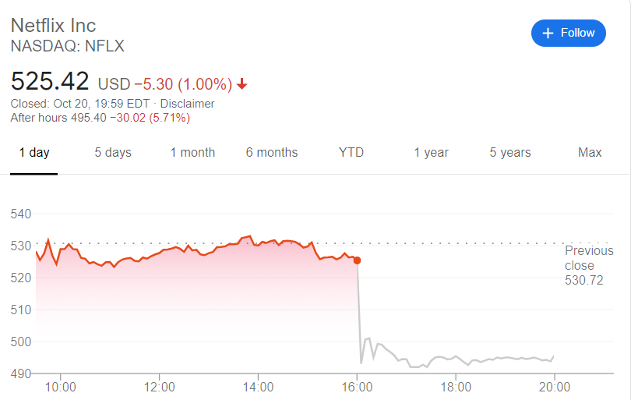 Netflix NASDAQ: NFLX
Netflix NASDAQ: NFLX released its Q3 earnings yesterday after the bell, and the market didn’t like the numbers; shares are set to open down more than 5% today.
NFLX had started to pull back over the past five sessions, and today’s open will take shares below the 50-day moving average.
The headliner was the 2.2 million net new subscribers, a little below the company’s 2.5 million forecast, but well below Wall Street estimates. Some on the Street were expecting 5 million+ net new subs.
Netflix was a big winner in the early innings of the pandemic, adding 15.8 million subs in Q1 and 10.1 million in Q2. In the company’s letter to shareholders, Netflix attributed the Q3 slow down to a “pull-forward effect.”

That may very well be the case, and Netflix does see Q4 net adds rebounding to 6 million. But bigger picture, it’s tough to see annual net adds continuing at previous levels; 28.6 million in 2018, 27.8 million in 2019, and a projected 34 million in 2020.
Let’s start by looking at why net adds are unlikely to continue in the ~30 million range, before considering how that impacts a decision to invest in Netflix.
Tough Sledding in Domestic Market
Netflix reported less than 200,000 net adds in the US and Canada in Q3, and now has just over 73 million subscribers in the two countries. That’s a high penetration rate, considering that the combined population is less than 400 million and password sharing means that a lot of Netflix users are not included in that number.
Domestic growth is certainly going to be a challenge, but even maintaining that 70 million+ number is no guarantee. Netflix faces a lot of streaming competition; Disney+ NYSE: DIS, Apple+ NASDAQ: AAPL, Prime NASDAQ: AMZN, and Hulu are just a few.
Netflix is still the leader – and I don’t see that changing anytime soon – but its lofty valuation means that it needs to stay well ahead of the pack.
International Has Potential to Drive Growth in 2021 and Beyond
The international growth rates are much more encouraging for Netflix than the US/Canada combo, which saw total paid subs increase 8.9% yoy in Q3:
- EMEA total paid subs were up 31.4%.
- LATAM was up 23.6%.
- APAC increased 62.1%.
Now, these are total paid subs, and these regions all recorded much fewer net adds in Q3 than in the first two quarters. And the starting numbers are lower than the US/Canada, which is responsible for 37.5% of all Netflix paid subs.
But, unlike the US/Canada, Netflix still has a lot of potential new subscribers abroad.
What About the Competition?
Though Netflix faces competition abroad, it doesn’t compare to what it faces domestically.
Hulu isn’t even available abroad for the time being.
Disney+ – perhaps Netflix’s most formidable long-term competition – is well behind Netflix when it comes to local-language content.
A big part of Prime Video’s appeal is that it comes with the Prime package – including free two-day delivery. Well, free two-day delivery is only available in around 20 countries.
The bull case for Netflix, in Q4 2020 and beyond, calls for the lion’s share of growth to take place abroad.
Will It Be Enough?
Netflix is trading at more than 75x forward earnings. Look another year out, and it’s still trading at more than 50x its earnings projections.
The steep earnings multiple is what concerns me.
A common argument from Netflix bulls says that once the company matures, earnings will increase as a percentage of revenue. Netflix has to invest heavily in original content right now to solidify its lead, the story goes, and that won’t be the case forever.
I’m really skeptical on that front, as the competition is only getting more intense and many of the new entrants have deep pockets.
Ditto on the argument that Netflix can raise prices a lot more without losing existing subscribers or turning off potential new subscribers. With the number of alternatives increasing, it’s only a matter of time before Netflix can’t raise prices anymore.
Wait for a Correction
I still think Netflix is an excellent company and I can see solid growth moving forward – if not as high as before.
International markets can propel Netflix for years to come, extending this growth story longer than many anticipate.
But the valuation remains steep, and this correction looks like it has a ways to go. Keep an eye on Netflix, and consider getting in if the sell-off goes too far.
Before you consider Netflix, you'll want to hear this.
MarketBeat keeps track of Wall Street's top-rated and best performing research analysts and the stocks they recommend to their clients on a daily basis. MarketBeat has identified the five stocks that top analysts are quietly whispering to their clients to buy now before the broader market catches on... and Netflix wasn't on the list.
While Netflix currently has a "Moderate Buy" rating among analysts, top-rated analysts believe these five stocks are better buys.
View The Five Stocks Here
Wondering when you'll finally be able to invest in SpaceX, StarLink, or The Boring Company? Click the link below to learn when Elon Musk will let these companies finally IPO.
Get This Free Report